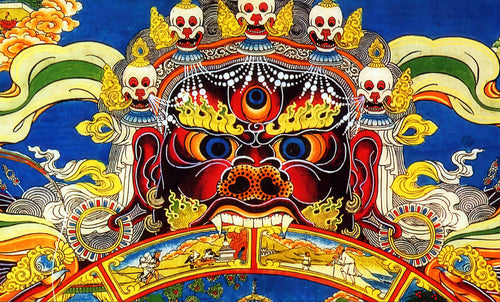
A precise point of reference is needed, an archetype
Rocco FontanaWe need a precise point of reference, a model, an archetype , an avatar , otherwise we are not able to define who we are. Listen to me carefully: I am trying to take you along a path that I have very clear in mind and that I am trying to translate into an understandable language. The human mind analyzes, compares, finds merits and objections to everything, every thought. It tends to necessarily find a satisfactory answer to a problem, most of the time with compromises and justifications; it is made like this, the mind never calms down.
The mind is a beautiful mechanism, use it, but don't be used. It is in the service of feelings: if thought serves feelings, everything is in balance; deep stillness and joy arise in your being.
(Osho)
There is a need to bypass and undermine all of this with reference points that are beyond our reach.
The idea began to flash during some of my research on the structure of Gurdjieff's Enneagram . I have already explained it in a previous article, but I will summarize it here for convenience. The Enneagram has six obvious points plus three others that are in motion inscribed in a triangle (the Triad), so we have 6+3 points. The Triad has a central point of rotation, which coincides with the center of the circle that includes it. This center is the object of our observation; an object that is then unraveled and analyzed on the entire Enneagram. Here we have 6+3+1= 10 points in the Enneagram. It could have ended here, 10 is a divine number, the tetraktys . But the symbol has no reason to exist without what quantum physics defines as the "observing subject", this is because reality is created by the observing subject (I). Here the points have become 6+3+1+1= 11 points.
So we have an object (10 points) and an observing subject (1 point), but it didn't seem complete to me.
The objection was always: “Okay, but compared to what?” I admit that it was becoming vaguely obsessive.
Another number whispered in my ear: 12! This number doesn't seem bad at all, in fact:
- 12 is the number of pairs of cranial nerves.
- 12 is the number of thoracic vertebrae.
- 12 is the number of pairs of ribs.
- 12 is the number of phalanges in the fingers of a hand, excluding the thumb.
- There are 12 months (complete lunations) in a solar year.
- There are 12 signs of the zodiac with which the year is divided in another way.
- A day is divided into 12 hours in the morning and 12 hours in the afternoon.
- The circumference of the watch dial is divided into 12 parts.
- 12 is the number of signs of the Western, Chinese, Indian, etc. zodiac.
- Approximately 12 years is the time it takes Jupiter to complete the circle of the zodiac and corresponds to the first return of Jupiter to its natal position.
- In the Western musical system, by convention, an octave is made up of 12 semitones.
- In Roman law, one of the first written codifications is represented by the laws of the XII Tables.
We thus have 3 subjects forming a new Triad: the subject (I), the object (arranged on the Enneagram) and the 12th point: the archetype or avatar .
According to Gurdjieff, and many ancient traditions, the forces that interact are not two, as according to traditional physics, but three; he called them Affirmation (positive), Negation (negative) and Conciliation (neutral). Only two antagonistic forces tend to cancel each other out, so the third force determines the outcome of the action. In more familiar terms these Forces can also be indicated as: Father (positive), Son (negative) and Holy Spirit (neutral).
I suggest that this Triad is part of a larger Enneagram, but let's move on; this whole lesson to get to the crux of the article: we can define someone or something only if we use a yardstick.

We are shaped by our thoughts; we become what we think. When the mind is pure, joy comes like a shadow that never leaves us.
(Buddha)
In the Fourth Way school I attended, the archetype, the avatar used as a reference was the figure of God. As an unknowable and unattainable figure, God provided us, regardless of whether we were believers or not, an unequivocal and incorruptible model. This allowed us to define ourselves and understand our position in the universe, which I personally also found relaxing.
The reader can discover for himself the figures, the avatars that can be most useful to him.
This entire article is to suggest to you, patient reader, every time you ask yourself who you are, what you are, how you are, to ask yourself: “… compared to whom?”
I've finished this article and I can hear copious and cheerful laughter coming from the "Zen department", but that's another story.. :-)
















































